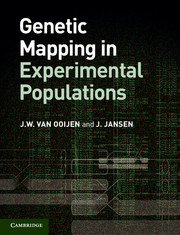Book contents
- Frontmatter
- Contents
- Preface
- 1 Introduction
- 2 Meiosis and genetic recombination
- 3 Estimation of recombination frequencies
- 4 Determination of linkage groups
- 5 Estimation of a genetic map
- 6 Criteria for the evaluation of maps
- 7 How to find the best map order
- 8 Outbreeding species
- 9 Mapping in practice
- Answers to exercises
- Index
- References
1 - Introduction
Published online by Cambridge University Press: 05 August 2013
- Frontmatter
- Contents
- Preface
- 1 Introduction
- 2 Meiosis and genetic recombination
- 3 Estimation of recombination frequencies
- 4 Determination of linkage groups
- 5 Estimation of a genetic map
- 6 Criteria for the evaluation of maps
- 7 How to find the best map order
- 8 Outbreeding species
- 9 Mapping in practice
- Answers to exercises
- Index
- References
Summary
Around 1900, scientists tried to understand the relationship between the inheritance of simple traits and observations of meiotic cell division under a microscope. It was the time that Mendel's laws on the inheritance of traits (Mendel, 1865) were rediscovered. Mendel did not have any idea of the biological mechanisms underlying his laws. However, some 35 years later, after studying Boveri's 1902 paper, Sutton (1902) realized that chromosomes and their behaviour in meiotic cell division could very well explain Mendel's results. However, in the many experimental crosses carried out to study the simultaneous inheritance of two traits, occasionally large deviations from Mendel's Law of Independent Assortment were observed. Bateson et al. (1905) described these deviations in terms of coupling of the heritable factors determining the traits. In subsequent work by Morgan and others, it became clear that heritable factors could be grouped with respect to the law of independent assortment: if two factors belonged to the same group, then their inheritance showed some interdependence; otherwise, the law would hold. In other words, they started realizing that these groups corresponded with chromosomes. By 1911, Morgan showed the possibility of recombination between factors lying on the same chromosome (Morgan, 1911a). Morgan assumed that this was due to an interchange (as he called the crossing over) between homologous chromosomes during meiosis. This corresponded very well with the detailed cytological observations of Janssens (1909). Later, Morgan (1911b) suggested that the heritable factors should be located in a linear fashion on the chromosomes and that the degree of coupling between traits would depend on the distance between the factors on the chromosomes. Sturtevant (1913), a student of Morgan, tested the hypothesis that the proportion of crossovers (as he called the recombinants) could be used as an index of the distance between two factors. He argued that, after determining distances from A to B and from B to C, it should be possible to predict the distance from A to C and to determine the order of the factors on the chromosome. Sturtevant successfully analysed six factors located on the sex chromosome of Drosophila and thus became the first ever person producing a genetic map. With his work, the chromosome theory of inheritance became really established.
Information
- Type
- Chapter
- Information
- Genetic Mapping in Experimental Populations , pp. 1 - 8Publisher: Cambridge University PressPrint publication year: 2013
